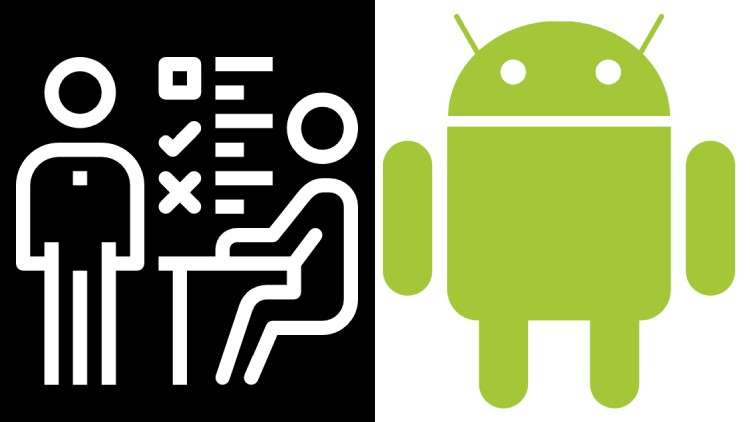![600+ Android Interview Questions Practice Test [2023]](https://studybullet.com/wp-content/uploads/2023/12/5715132_29fe_2.jpg)
Android Interview Questions and Solutions Preparation Follow Take a look at | Freshers to Skilled | Detailed Explanations
What you’ll study
In-Depth Understanding of Android Fundamentals and Superior Ideas
Proficiency in Designing and Implementing Android Consumer Interfaces
Experience in Android System Structure and Software Elements
Expertise in Testing, Debugging, and Optimizing Android Purposes
Description
Android Interview Questions and Solutions Preparation Follow Take a look at | Freshers to Skilled | [Updated 2023]
Welcome to “Grasp Android Growth: Final Interview Follow Exams,” your complete information to acing Android developer interviews. This course is meticulously designed to offer you in-depth information and hands-on apply by means of a collection of focused apply assessments. Whether or not you’re a newbie aspiring to start out a profession in Android improvement or an skilled developer seeking to brush up in your abilities, this course affords invaluable assets that will help you succeed.
- Android Fundamentals
- Exercise Lifecycle: Dive deep into the Android Exercise lifecycle, understanding the best way to handle state modifications and protect consumer information.
- Intents and Intent Filters: Grasp the communication framework inside Android apps, together with specific and implicit intents.
- Consumer Interface Elements: Be taught the constructing blocks of Android UIs, from buttons to textual content views, and the best way to successfully lay out your interfaces.
- Android Manifest: Uncover the necessities of the Android Manifest file, understanding its position in app configuration and permissions.
- Knowledge Storage Choices: Discover varied information storage choices in Android, together with shared preferences, inside and exterior storage.
- Supporting Totally different Display Sizes: Be taught methods to make sure your app seems nice on all gadgets, no matter display measurement or density.
- Superior Android Ideas
- Fragments and their Lifecycle: Acquire experience in utilizing Fragments, essential for adaptable Android UIs, and perceive their lifecycle.
- Android Companies: Delve into the world of background processing with Companies.
- Broadcast Receivers: Find out how apps can talk with one another utilizing broadcast receivers.
- Content material Suppliers: Perceive the best way to share information between completely different Android functions securely.
- Asynchronous Processing in Android: Grasp asynchronous processing methods, essential for easy consumer experiences.
- Android Networking: Get accustomed to networking in Android, protecting APIs and libraries for internet communication.
- Android Consumer Interface
- Layouts and View Teams: Discover the varied format managers and the best way to create dynamic and responsive UIs.
- Customized Views: Be taught to create bespoke UI elements tailor-made to particular app necessities.
- Animation and Graphics: Add life to your apps with animations and customized graphics.
- Menus and Consumer Navigation: Perceive the best way to create intuitive navigation and menus for a seamless consumer expertise.
- Dialogs and Toasts: Grasp the artwork of suggestions and alerts with dialogs and toasts.
- Adapters and ViewHolders: Delve into adapters for environment friendly information presentation in lists and grids.
- Android System Elements
- Understanding Context: Unravel the idea of Context, its makes use of, and finest practices.
- Managing System Assets: Be taught environment friendly administration of system assets to construct responsive functions.
- Android Software Elements: Get a complete understanding of the constructing blocks of Android apps.
- Android Software Threads: Perceive threading in Android to keep up a responsive UI.
- Intent Decision: Grasp how Android resolves intents to attach elements.
- Dealing with Permissions: Be taught finest practices for managing app permissions in step with consumer privateness and safety.
- Android Testing and Debugging
- Android Testing Framework: Familiarize your self with the Android testing panorama, together with unit and integration testing.
- Unit Testing in Android: Be taught the significance and methods of unit testing in Android functions.
- UI Testing with Espresso: Dive into UI testing with Espresso for strong, maintainable, and dependable UI assessments.
- Debugging Android Purposes: Grasp debugging methods to effectively discover and repair points in your apps.
- Efficiency Optimization: Be taught methods for optimizing app efficiency and making certain easy operation.
- Reminiscence Administration in Android: Perceive reminiscence administration to stop leaks and optimize app efficiency.
- Superior Matters and Greatest Practices
- Dependency Injection in Android: Find out about dependency injection and the way it enhances testability and modularity in Android apps.
- Materials Design Rules: Embrace Materials Design ideas for aesthetically pleasing and practical UIs.
- Android Structure Elements: Rise up to hurry with the most recent Android Structure Elements for strong app design.
- Reactive Programming with RxJava: Discover the facility of reactive programming in Android with RxJava.
- Securing Android Purposes: Perceive finest practices for securing Android functions towards widespread threats.
- Leveraging Kotlin in Android Growth: Find out how Kotlin could make your Android improvement quicker, safer, and extra pleasant.
Continuous Updates for Ever-Evolving Android Growth:
Within the dynamic subject of Android improvement, staying up to date with the most recent developments, instruments, and finest practices is essential. That’s why our course, “Grasp Android Growth: Final Interview Follow Exams,” is often up to date. We be sure that our questions replicate probably the most present requirements and developments within the Android ecosystem. This dedication to steady enchancment means you’re at all times making ready with related, up-to-date materials.
Pattern Follow Take a look at Questions:
- Query: What’s the main operate of the Android Manifest file?
- A) To listing all of the actions within the utility
- B) To outline the app’s format
- C) To declare permissions and utility necessities
- D) To handle the app’s information storage
- Reply: C) To declare permissions and utility necessities
- Rationalization: The Android Manifest file is a vital element in Android functions. It performs a number of key roles, akin to declaring the app’s package deal identify, which uniquely identifies the app on the gadget and within the Google Play Retailer. It additionally specifies the app’s entry factors and elements, akin to actions, providers, broadcast receivers, and content material suppliers. Most significantly, it declares the permissions the app requires, akin to web entry or entry to the gadget’s digicam. It additionally lists the Android API ranges which might be suitable with the app, making certain that customers with gadgets operating incompatible variations of Android can’t obtain the app.
- Query: What’s the significance of the ‘onCreate()’ technique within the Android Exercise lifecycle?
- A) It’s known as when the app is updating UI components.
- B) It initializes the exercise and hundreds UI elements.
- C) It saves the app’s persistent state.
- D) It manages community connections.
- Reply: B) It initializes the exercise and hundreds UI elements.
- Rationalization: The ‘onCreate()’ technique is step one within the lifecycle of an exercise. It’s known as when the exercise is beginning and is used to carry out one-time initialization, akin to establishing the consumer interface by inflating layouts and initializing class-scope variables. This technique gives a Bundle parameter if the exercise is being re-initialized after beforehand being shut down, permitting the exercise to revive any saved state, akin to UI components and member variables. Understanding ‘onCreate()’ is essential for correctly establishing an exercise and making certain a easy consumer expertise.
- Query: How does Android deal with completely different display sizes and densities?
- A) By proscribing app set up on sure gadgets
- B) Utilizing a single, common format
- C) By way of responsive layouts and useful resource qualifiers
- D) Mechanically cutting down high-resolution belongings
- Reply: C) By way of responsive layouts and useful resource qualifiers
- Rationalization: Android gives a versatile framework for adapting app layouts to completely different display sizes and densities. Builders can create completely different format information for varied display sizes by utilizing size-specific useful resource directories (like layout-small, layout-large). Moreover, Android helps density-independent pixels (dp) and scale-independent pixels (sp) for outlining UI components, making certain that they seem comparable throughout gadgets with completely different display densities. Useful resource qualifiers enable for the customization of belongings like pictures, making certain they’re optimized for varied display resolutions. This strategy allows Android apps to offer an optimum consumer expertise throughout a variety of gadgets.
- Query: What position do Broadcast Receivers play in Android apps?
- A) They’re used to persist information in a database.
- B) They reply to system-wide broadcast bulletins.
- C) They deal with format inflation.
- D) They handle the app’s background providers.
- Reply: B) They reply to system-wide broadcast bulletins.
- Rationalization: Broadcast Receivers in Android are used to reply to broadcast messages from the system or different functions. These messages might be system-wide occasions (like boot accomplished, battery low) or application-specific messages. For instance, an app may broadcast a customized intent when new information is accessible for different elements to make use of. Broadcast Receivers are registered both statically within the Android Manifest or dynamically within the code. They permit apps to react to occasions even when the app shouldn’t be actively operating, making them a robust function for creating responsive and context-aware functions.
- Query: What’s Dependency Injection and the way is it carried out in Android?
- A) A way to extend app measurement
- B) A method to cut back the modularity of an app
- C) A design sample to reinforce testability and upkeep
- D) A course of to handle reminiscence in Android apps
- Reply: C) A design sample to reinforce testability and upkeep
- Rationalization: Dependency Injection (DI) is a design sample that improves the modularity and testability of Android functions. It includes offering objects that an object wants (its dependencies) slightly than having it assemble them itself. This separation of issues makes the code extra modular, simpler to check, and preserve. In Android, DI might be carried out manually or utilizing frameworks like Dagger or Hilt. These frameworks deal with the creation and lifecycle of dependencies, simplifying the event course of. By utilizing DI, builders can create loosely coupled and scalable Android functions.
Enroll Now: Be part of “Grasp Android Growth: Final Interview Follow Exams” right this moment to spice up your confidence and competence to your subsequent Android developer interview. This course is your key to unlocking the doorways of alternative within the ever-evolving world of Android improvement.
Content material
Discovered It Free? Share It Quick!
The submit 600+ Android Interview Questions Follow Take a look at appeared first on destinforeverything.com/cms.
Please Wait 10 Sec After Clicking the "Enroll For Free" button.








